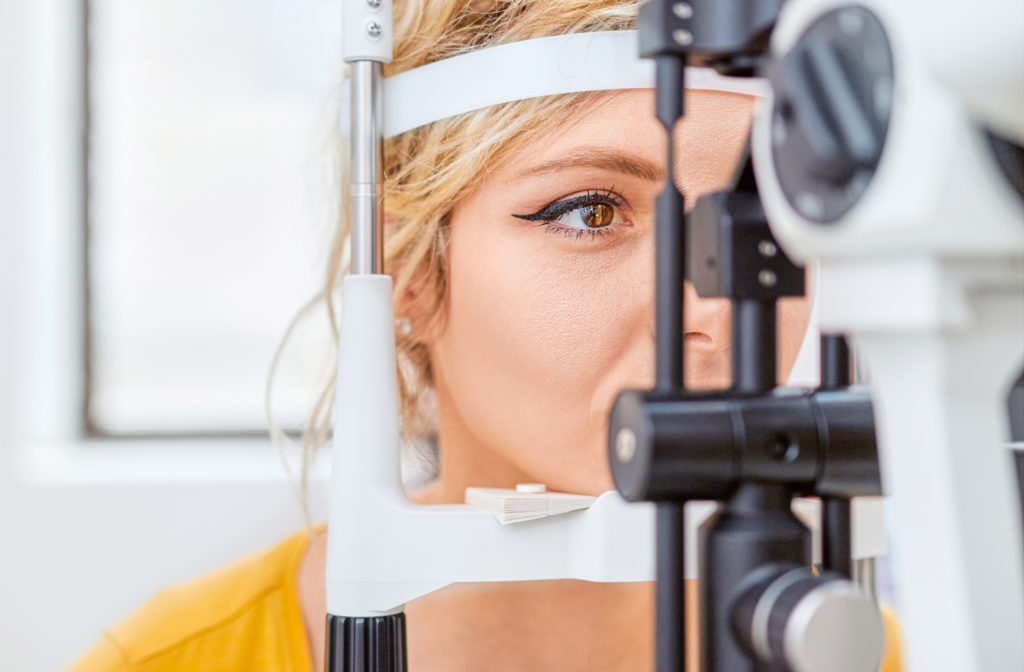The Slit Lamp Examination is a very common non invasive test used for diagnostic purposes. It allows your doctor to check all major sections of your eye and provides a way to catch eye diseases early on before there are lasting consequences.
It’s best employed along with other diagnostic tools when having routine eye exams. So be sure to keep your visual health in check and schedule regular eye doctor visits!
What Exactly is a Slit Lamp?
A Slit Lamp Examination, also called biomicroscopy, is a common eye exam that’s regularly done during eye doctor appointments with a machine called the slit lamp. There are 3 components to this machine: a frame to rest your head in, a lamp that shines the slits of light into your eyes, and a microscope.
The frame is a simple device to rest your head on, designed to keep you as comfortable as possible while also keeping your eye steady..
The slit lamp allows your eye doctor to point a beam (or slit) of light angularly at specific parts of your eye. This slit of light can be narrowed, widened, made brighter, and even color-filtered by your optometrist to give them a better view of the small and delicate parts of your eyes.
The microscope then provides your doctor a magnified 3D view of both the inner and the outer parts of your eyes, which lets them diagnose several potential eye problems.
What’s the Procedure?
Once you’re in the examination chair, your eye doctor will properly fit you in the support where you rest your head. This support frame is comfortable and helps support your neck during the brief testing process.
After a first look, your optometrist may then use eye drops with a specific dye called fluorescein. This dye gives them a better view of the complex organ that is your eye and makes the overall exam easier. They may also apply drops that dilate your pupils, especially when a thorough examination of the back of your eye is necessary.
After the eye drops take effect, your optometrist will start properly examining your eyes. They’ll shine the slit of light with varying degrees of brightness, angle, and width into different parts of your eye. As they’re doing that, they’re also examining specific sections of your visual system with a microscope, looking for any eye abnormalities you might have.
Best of all, this is a simple and comfortable procedure. You don’t need to prepare for this process, and it’s done right at your eye doctor’s office. Although if dilating eye drops are used, you’ll need a pair of sunglasses and a ride home.
Why is the Slit Lamp Important?
Finding eye diseases before they progress into lasting damage is crucial, since our eyes dictate how we understand and interact with the world around us.
The slit lamp examination is particularly important to this end because it enables your eye doctor to examine all major areas of your eye. The importance of this test is immense, as finding eye diseases early on can be the difference between sustained ocular health and vision loss.
What Slit Lamps Reveal
The slit lamp shines a light on all major structures of the eye, such as:
- Iris – The small black dot in your eyes that controls the light influx
- Lens – Transparent structure whose job is to focus light rays into the retina
- Cornea – Transparent part in charge of refracting or bending light
- Optic nerve – Nerve whose job is to relay information from your eyes to your brain via electrical impulses
- Eyelids
- Sclera – The white part of your eye globes that provides protection
- Retina – Responsible for creating the electrical impulses that reach your brain
What Can it Help Diagnose?
The importance of regular eye exams can’t be overstated. They provide your doctor a timeline of how your eye’s change as you age, and help you detect eye diseases before they progress into serious eye damage.
The slit lamp examination is indispensable as a preemptive care measure. It is commonly done as part of routine eye exams because it can detect serious eye-related problems such as:
- Glaucoma or other optic nerve diseases
- Cataracts
- Damage or detachment of the retina
- Damage or injury in your cornea
- Macular Degeneration – a common degenerative disease that can lead to central vision loss
The onset of these diseases and other eye conditions can have devastating consequences. This is why you should have regular visits to an optometrist, as discovering these ailments early on is paramount to your eye health.
Early Detection Equals Eye Wellness
Your eye doctor may give your test results immediately after the examination. If any abnormalities are found, they can start planning the best course of action right away.
Preemptive care is your best bet against ocular disease. Early detection makes a world of difference when the subject is eye wellness. The slit lamp examination is a big part of any comprehensive eye testing. So be sure to schedule regular visits with your optometrist to maintain healthy eyes and a happy lifestyle.




